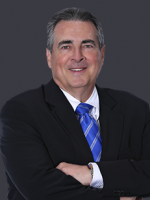Land use and zoning attorney, Stanley Price and Vicky Leiva, talk about homeless assistance centers in the City of Miami and how to deal with neighborhood opposition.
Transcript:
VICKY LEIVA
Welcome to Land Development in the 305, a podcast featuring news, observations, and analysis on the redeveloping and reshaping of South Florida’s skyline. I am Vicky Leiva with the law firm of Bilzin Sumberg in the Land Use and Government Practice Department, and with me is Stan Price.
STANLEY PRICE
Thank you, Vicky. I am senior counsel to the firm, and we are going to discuss a very interesting case that you and I handled back in the 1990s, and I look forward to discussing it with you.
VICKY LEIVA
So as we proceed, today is about a homeless assistance center that was developed by our group for the City of Miami. The homeless assistance center today serves the homeless community and has grown in service capacity from the initial approvals. The center population is approximately 44% families with children. We also note today that approximately 25% of the homeless population suffers from some form of mental illness. We have also learned that homeless people do not migrate for services. These have become critical information that we have today that we did not have when we were doing this, Stanley, right?
STANLEY PRICE
This was a somewhat unique situation which in the land use area is known as NIMBY, not in my backyard. We were approached in the early 1990s by county commissioner Alex Penelas who became mayor of Dade County as well as Alvah Chapman, who is designated by the community to chair the homeless assistance center. This was a very controversial case, and we will discuss that today or its ramifications it’s had on the community.
VICKY LEIVA
How did you come about being asked to represent this effort on behalf of the county commission?
STANLEY PRICE
Well, we were approached by Alvah Chapman, and he had asked us whether we would be interested in donating our pro bono practice to assist the community in establishing the first homeless shelter in Dade County. We were honored to be asked to do that and we agreed to take the representation and it had turned into one of the most interesting cases that I have ever personally been involved with.
VICKY LEIVA
Stanley, I recall facing opposition like we had never seen before in any of the cases we worked on. Can you tell us a little bit about the opposition, where it came from, and how you dealt with that?
STANLEY PRICE
Well, several of the major condominiums in the area, the center was to be located on 15th Street and Miami Avenue, this was several blocks west of a fast-evolving residential neighborhood to the east, and the magic words “homeless” triggered a very negative connotation in the area. It led to many of the condo associations organizing and reacting in an extremely negative fashion. We had filed the application, and the application was a very interesting architectural rendering that would be a service center, a housing facility, a coed housing facility and a family housing facility, as well as an educational component to the center. We submitted our plans to the City of Miami, which was a jurisdiction in which the property was located, and we had met with the Zoning and Planning Department of the City on several occasions.
VICKY LEIVA
And as I recall, one of the greatest issues that kept coming up was the fear of loitering around this area and part of those architectural drawings included an indoor courtyard where individuals who were looking for or asking for assistance could wait to get that assistance.
STANLEY PRICE
The homeless assistance center through the leadership of Mayor Penelas that was then County Commissioner Penelas and Alvah Chapman conducted very detailed research of other facilities in the country and what worked and what did not work. Our job was to convey to the City of Miami that a lot of the fears and transgressions that people perceived for the center would not come to fruition and our plans incorporated many of the ingredients that were successful in jurisdictions like Orlando and other parts of the country.
VICKY LEIVA
As I recall, shortly before we filed the application, the City of Miami made changes to its ordinance, and for the first time homeless shelters were identified separately from other uses and required a procedure of at least two different and separate hearings; one at the planning and zoning board level and the other one at the city commission level. How did you approach and prepare for those hearings?
STANLEY PRICE
The preparation for these hearings was to preclude the negative connotations that were perceived by the community and show through an operational plan that the Center was going to be able to address and not ripen into a nuisance into the area. We worked very closely with staff, the staff worked with our architect, and we came in with a plan that was acceptable to the professional people of the city and then we were charged with selling this to the planning and zoning board. We proceeded to the planning and zoning board a very, very controversial hearing, but the overwhelming consensus of the board was the community had to face this problem. It was a serious problem in our community and these facilities had to be placed somewhere and they felt that both on the location and the actual physical plant that this was the correct location for this property.
VICKY LEIVA
Do you recall where the hearing was held?
STANLEY PRICE
Well, the planning and zoning board was held at Dinner Key, which is where the city conducted the hearings, but following the approval by the planning and zoning board, the matter was appealed to the city commission. We went to the hearing, and I might add it was almost impossible to find a parking spot near the Dinner Key Auditorium, and when we eventually made it into the hearing room with police protection, I might add, the commission had a quorum and Mayor Clark, witnessing what was happening in the crowd and the fact that half the community was outside, ruled that the meeting should not take place and that they should -- this matter should be deferred and moved to a location that could accommodate the masses of people attending the hearing.
VICKY LEIVA
And as I recall, it was moved to the James L. Knight Center, which seats 5,000 people and it was pretty much full when that second hearing was called.
STANLEY PRICE
It was full primarily with opposition to the -- to the plan. There were several, I would say 10 to 15 police officers that separated the objectors from the representatives of the Homeless Assistance Center, and it was a very, very chilling effect. I’ve been to controversial hearings in the past, but this evoked some emotions that I had never seen before.
VICKY LEIVA
I remember going into the James L. Knight and seeing the atmosphere. The crowd was booing and screaming and throwing things even before the hearing had started. And as a young associate, I turned to you, and I said Stan, how are you going to control this situation. I think the listeners would enjoy hearing what -- what you told me and how you were going to do it and how in fact, you did it. And now a break for an announcement.
Have you heard of the Second Annual South Florida Redevelopment Conference? Bilzin Sumberg is hosting this invite-only conference on March 13, 2020, featuring expert keynote speakers and panelists to highlight the latest in the redeveloping and reshaping of the Miami skyline. To RSVP to this event, email events@bilzin.com, that’s events at B-I-L-Z-I-N dot com.
STANLEY PRICE
I think I told you, Vicky, that I’m leaving, and you’re going to handle the hearing, but that did not occur. We knew that we had a positive staff recommendation. We knew that Mayor Clark, who was then the mayor of the City of Miami, who used to be the mayor of Dade County when I served as his legal counsel on zoning matters, was preordained to support this center. We had to get three votes out of the five. And because this was an appeal from the planning and zoning board by the neighbors, the neighbors went to go first, and they took about an hour, maybe a little more than an hour to present their case. They were represented by very competent counsel. One neighbor after another used the concept as would you want this in your neighborhood, which played well to some city commissioners, but not to others. And the crowd was cheering, booing statements made by some city commissioners. So at the end of the hour and a half, we had prepared our clients with a roster of who was going to speak and the order in which they were going to speak. There was a short break between the opposition testimony and when our position was going to be advocated. I approached Mr. Chapman and Commissioner Penelas and I suggested that we change the orders of the speakers in order to calm the crowd down and one of our speakers was Archbishop McCarthy, who was a very well-respected member, very priestly, to describe his mannerism and his speech, and they agreed with me that that would be a good idea to let the Archbishop speak first. So I called the Archbishop as the speaker, and he walks up and they start booing and yelling and say you don’t even live in the neighborhood and I think I turned to you, Vicky, and I said I think we just won the hearing, because Mayor Clark was a devout Roman Catholic and when he saw people turning on the Archbishop, that was a very favorable aspect for us. We put our case on. We brought the architect up to describe the safeguards that we wanted to put in place, and we had two city commissioners who voiced approval of the project, two who were apparently in opposition to the project, and one commissioner who we were uncertain on how he was going to react. And after we put on our case for over an hour, which was a real exercise in civics in terms of the quorum and the like, people were rude and the mayor, as best he could, tried to control the crowd. But finally, a motion was put on the floor to approve the project. And they voted two to two, and when they got to the fifth commissioner who was uncertain, he started making a speech, a political speech in terms of how important this is for the community, but how he respects the fact that the community -- this community has been put on that they -- this is not necessarily the best location to put it in the city. And after self-debating himself basically, he said he’ll support the motion, but he has certain conditions which he’d like to apply. He then went through a list, and I believe it was over 30 additional conditions, some of them involving police presence at the site, private security, roaming security, things that would safeguard some of the negative annotations and connotations applied to homeless centers. And with that, the mayor asked would we agree to the conditions. My client really had no choice, and said they would agree to the conditions and the matter passed three to two. The place went crazy. Obviously, the objectors were totally dismayed and upset, and the supporters of the center were very elated for this aspect. What was very enriching as to me personally and to the firm is that we committed and obtained a public benefit. We’ve, through the years, rezoned two additional homeless assistance centers pro bono for the homeless assistance centers; one in Homestead and one in another location. And one of the benefits that we’ve had over the last 40, 50 years is that we can do this for the community without any financial benefit to us. And I still view our retention in this matter as a major compliment that we were asked to do something of this importance to the community. Alvah Chapman was one of the great people in this community and was recognized at the time as the probably number one civic leader in the County and Alex Penelas who was assigned this, which I don’t think he was looking forward to being assigned this project, went on to become mayor of Dade County. And when you go past the center you -- I have pride that I had some small part in creating this for the community.
VICKY LEIVA
Thank you, Stan. Thanks for listening to our podcast.





 />i
/>i
